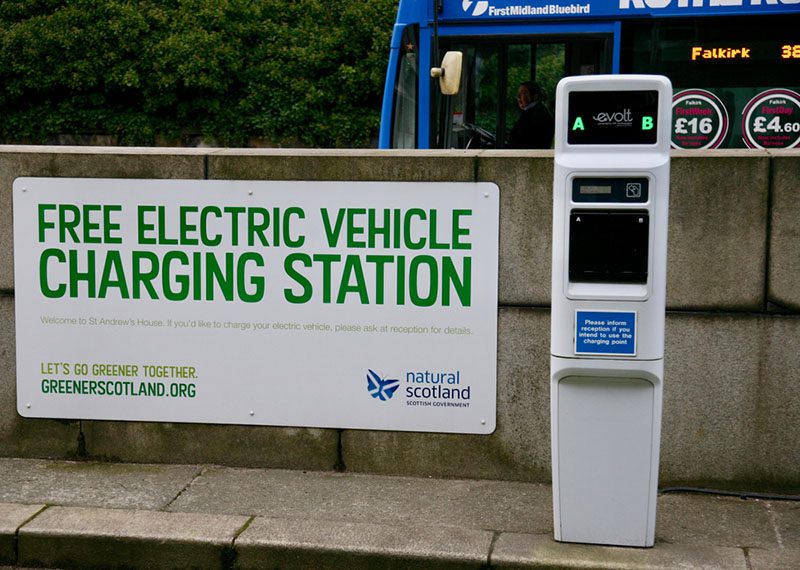Neil Bruce of Edinburgh based law firm Burness Paull LLP takes an in-depth look at what is needed in terms of policy and investment if the Scottish Government’s goal of phasing out new petrol and diesel cars and vans by 2032 is to be met.


Over the past decade there has been significant focus on electricity generation from renewable sources in the drive to reduce greenhouse gas emissions and tackle climate change – and rightly so, as Scotland has been a leader in the renewable energy field. However, an issue that has been addressed to a lesser extent is that transport is the largest net source of greenhouse gas emissions. That is why there is currently a surge in interest on the promotion of ultra-low emission vehicles (ULEVs), as part of the transition towards a low carbon economy.
With the Scottish Government’s Energy Strategy setting out its intention to tackle the electrification of transport, the headlines have been around the goal to phase out the need for new petrol and diesel cars and vans by 2032 (some eight years earlier than the UK government target).
An admirable ambition – but is it realistic?
Recent statistics show the number of ULEVs registered in Scotland for the first time in the period of January – September 2017 was up 66% on the corresponding figure in 2016. An impressive looking stat, and indicative of the way things are going to go in this space. To put it into context, however – the same statistics note that 99.2% of vehicles licensed for use on the roads in Scotland are still powered by either petrol or diesel. Although the 2032 target is not to outlaw all fossil-fuel burning vehicles completely, what is clear is that a huge shift in the current position is required.
Factors slowing the transition
A number of challenges exist in making this transition, and that is widely recognised by stakeholders across the energy and transport sectors and within Government. The public also need to have reason to make the change to using a ULEV. Current concerns around costs and perception, and in particular range-anxiety are undoubtedly factors in the relatively slow uptake when compared to countries such as Norway. Whilst grants and subsidies have been available in the UK, they are perhaps less understood, and to date have clearly not been significant enough to encourage more people to acquire an ULEV. Support in this regard is likely to be required (including potential scrappage schemes for diesel vehicles), and it is acknowledged that the Government will require to develop a system that balances this against the current system of taxation to generate funds to cover (for example) road maintenance.
The demand that will be placed on the grid for electric vehicles (EVs), and the need to significantly improve the charging / re-fuelling infrastructure as the numbers of ULEVs grow is another major issue. Ecotricity were one of the early entrants to the market, installing its first EV charge point at South Mimms services on the M25, back in 2011. Since then, Ecotricity have made a long-term commitment to sustainable transport in the UK and have installed a network of charging stations that covers almost the entire motorway network in England and Wales. It is acknowledged however that this is only part of the solution with regards to charging points and infrastructure, but not everyone will charge their EV at a motorway service station. Rather, most current owners of ULEVs will likely charge their vehicle at home overnight, but what of those whose homes do not have access to off-street parking? Catering for this category of ULEV driver will be a key nut to crack, together with the roll-out of charging infrastructure on A roads, cities, towns and villages across the country. It therefore goes without saying that for long-distance driving, more ULEVs will need more charging / re-fuelling points, and for EVs it is estimated that a significant increase in the number of chargers located near major road networks – in particular rapid chargers – will be required to cater for increased demand.
Ensuring adequate supply from the grid
Increased charging points, rapid charging and the significant take-up on ULEVs will also place a significant burden on the transmission and distribution networks, ensuring that there is enough electricity available on the system to meet demand. As an estimate (and in simple terms), 9 million EVs on the road by 2030 would require roughly 8 GW of new power generation to meet demand. This figure however is misleading as it does not take into account smart charging and is based on all vehicles charging at the same time, which is not envisaged. As consumers adapt to smart charging, the need for new generation and demand will not be as significant. This does however illustrate the importance of engagement across not simply the energy sector and network operators, but also in conjunction with the transport and technology sectors, to ensure we are best placed to ensure a smooth transition to ULEVs. This essence of this point and the need for collaboration was echoed recently by Graeme Cooper, Director of EVs at National Grid before Business Energy and Industrial Strategy Committee, where discussing the work of National Grid, Graeme commented, “we [National Grid] are looking at regulation and networks through the lens of the costs of networks. One thing that is really important, particularly when considering the move to decarbonising transport, is that this is three industries together. You have the energy industry, the transport industry and the digital industry, and all of those need to work together”.
Funding, of course, is an integral part. The Scottish Government has pledged to support its goal by, for example, expanding the charging infrastructure over the next four to five years, including its headline vision to turn the A9 into an “electric highway”. The Scottish Government has also talked about financial support for local solutions and small-scale research and development – whilst acknowledging that many of the key fiscal levers still rest with the UK Government (who also have a critical role to play).
It is clear, however, the private sector will have a large role to play in the required progression. As things stand, the appropriate funding model(s) may not be known – and is likely to develop with the sector itself, as investors consider how they might get comfortable with the levels of risk involved.
With advancements in technology, and the need to continue to progress the use of low-carbon technologies and processes, the uptake and momentum of ULEVs will only increase – be in no doubt this will be one of the key transformative events in our lifetime.
From policy to actual delivery
As with any revolution, it will present significant opportunities for those who can make it happen. However, there is often a perception among interested observers that the UK is adept at making policies and not always good at implementing them. It is also apparent that technology is moving at a pace that regulation and policy frameworks are struggling to cope with. There are challenges ahead in order to deliver the goals around low carbon transport and deployment of ULEVs. The task now is to be part of the solution, to overcome the challenges and be part of delivering – not just talking about it.
There is a very broad church of stakeholders with a role to play – from governments and public bodies to car manufacturers, utility providers, DNOs, energy developers, business owners and property owners, residential developers, charging-point developers and installers, lenders and investors – not to mention professional advisors (yes, including lawyers). We have had discussions with several clients and contacts who are active in this area, and who are giving detailed attention to seeking out the right opportunities and project partners to take things forward.
Technology is improving all the time (for example in the capability of batteries and the related charging facilities); car manufacturers are finding and will continue to find ways to reduce costs and bring the acquisition of a ULEV closer to the mind of the consumer, and as time passes the hope is that the population will pay more credence to the environmental benefits than simply the bottom-line impact on their wallet (albeit of course levels of support and subsidy may be required to set things on their way).
Addressing the charging points shortfall
The public nature of the charging network, particularly in Scotland, will not of itself be sufficient to meet the demands of the future. It is great that initiatives are being run by local authorities in cities looking to be at the forefront of advancements in this area – but for the scale of the movement that is required, private sector input is a must. We have seen initial moves by various players – but at this point, more time and money is being spent on the vehicles themselves than the infrastructure to back it up.
Solutions also need to be developed for those with no access to off-street parking. The appropriate answer may depend on each location but there is an opportunity for each of local authorities, residential builders and developers, charging infrastructure providers and property owners to consider how they might make best use of their projects and landholdings to put in place or be part of a network that is more accessible to those with no driveway.
Might this be addressed by designated public charging / re-fuelling areas in every new development? The introduction of public charging hubs in city-centre areas, or increased charging facilities at business parks, shopping centres, leisure centres and workplaces? And will there be a need for a roll-out of charging / re-fuelling hubs in place of petrol station forecourts?
For those who have existing energy-generating installations, advancements in this area may open the door to initiatives that neatly align the need for improvements in the required grid and charging infrastructure with the existing project.
Private sector investment will be critical, and with the current level of interest in this area there is little doubt that many different types of investor will be considering how they can get involved. Certainly equity investment seems more likely in the short term, however with the range of innovative models that have been developed in other sectors, we believe that many lenders are keeping a close eye on this space and are keen to support initiatives.
It is clear that this is a market that is on the move – and what is required is for the opportunities to be seized to avoid this being labelled as a classic example of a positive policy lacking in implementation.






